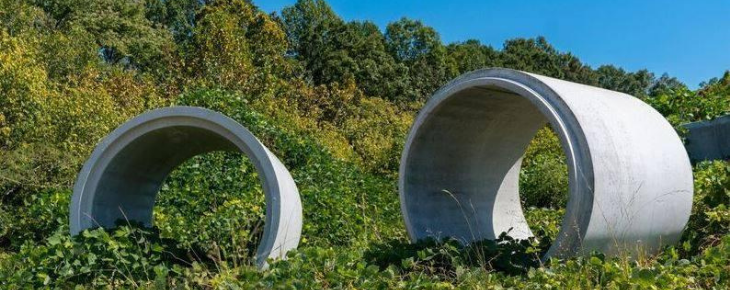
Environmental Considerations and Carbon Footprint of Drainage Pipe
In this four part series, the ACPA takes a look at the environmental factors surrounding concrete pipe, its production, and its usage. As the most widely used building material around the world, there is a lot of mis-understanding of the impact of concrete and its products on the environment. Each one of these blogs will help you better understand its impact.
In nearly every industry today, sustainability is a central focus. Are the products being produced and processes used to create them harmful to the air, water, or land? How can we measure the environmental impact of production and know with certainty we’re making a responsible choice for the environment? In the concrete pipe industry, we take sustainability very seriously. Our products are locally available, produced with materials from the earth, and designed to last for generations.
Let’s take a look at what sustainability means within the concrete pipe industry its carbon footprint.
Environmental Sustainability
The central focus of environmental sustainability is limiting – or eliminating – the negative impacts that a system or product has on the natural world. This includes reducing immediate and long-term impacts on air quality, water quality, ecosystems, climate, and land use.
It is important for designers and project owners to understand the differences between available pipe materials (typically concrete, thermoplastic, and metal) and what each pipe material contributes towards environmental sustainability. This involves comparing the environmental impacts of not only the manufacture of these different products, but also looking at the differences in transportation, installation, and end-of-life characteristics for a complete system because each pipe material has its own distinct properties and requirements.
Environmental Considerations
There are several categories considered for environmental analyses of given products. Life-Cycle Assessments (LCAs), such as those produces by SCS Global Services, evaluates products in categories such as climate change, acidification (acid rain), smog formation, eutrophication (water pollution), and ozone layer depletion . Water consumption is also commonly included in environmental impact statements, especially in the western United States where water scarcity is a significant concern.
The most familiar category of sustainability to many is climate change, which is primarily affected by the emission of Greenhouse Gases (GHG). Of all the classified greenhouse gases, CO2 is widely considered the largest contributor to climate change by total quantity of emissions; however, other gases have a measurably worse impact on the environment per unit weight.
For instance, 1kg of methane, while less common than CO2, can contribute the same amount toward warming the Earth’s atmosphere as 25 kg of CO2 . The simplest way to compare the basic environmental impact of drainage pipes is to convert the associated emissions of each product into terms of carbon dioxide equivalent (CO2e). While this is certainly not the complete picture, it allows users to compare products and methods from an environmental standpoint at a glance.
Carbon Footprint of Drainage Pipe
To measure and compare the environmental sustainability of any system or group of products, it is common to look at the total GHG emissions associated with the production of a given product. This can be encompassed in something called a cradle-to-gate analysis in which products are evaluated through each step of production. From mining of raw material to the finished product (prior to distribution and use),the emissions associated with each production phase are factored into a total embodied emissions value. Several studies have evaluated the cradle-to-gate emissions of different pipe materials, but most evaluations stop after the product has been produced and ready to be shipped.
Environmental Product Declarations, or EPD’s are made available for many product types, but generally don’t go further than evaluating acquisition of raw materials and the subsequent manufacturing processes. While this process may account for a significant portion of total emissions, there are more pieces to the puzzle that can drastically change results when comparing different product types.
Since the transportation, installation, maintenance, and end-use of different pipe materials may look significantly different, it is important that the emissions associated with these other elements also be factored in. The term for a product evaluation that encompasses all associated environmental impacts through production, distribution, installation, and end-use is called a cradle-to-grave analysis.
For instance, the Concrete Piping Systems Association (CPSA) in the UK produced a third-party-verified comparison of reinforced concrete pipe (RCP) and high-density polyethylene (HDPE) pipe material production. . The report accounts for notable differences between concrete pipe and plastic pipe in terms of cradle-to-gate and gate-to-site emissions as well as the mining and transport of imported backfill for each product type but did not quantify values for installation procedures, maintenance/operation, or end-use into the final product emission values. However, in going just a little further beyond cradle-to-gate emissions in their evaluations, this report concluded that RCP emissions are nearly 35% less than HDPE. Environmental sustainability is clearly an important consideration for all of us who are designers, influencers, and decision makers responsible for shaping our future world. In doing so, it’s essential that we do our due-diligence to understand these key differences and distinctions between manufactured products.
To learn more about concrete pipe and sustainability, register for our complimentary webinar on May 20th, 2021.
